T2K has now been running for over a decade and has successfully accomplished its initial physics programme, although as more data are acquired there will be further improvements in the measurement of neutrino oscillation parameters and interaction cross-sections. However, as more statistics are gathered, it becomes important to improve the detector so that systematic errors (that is, uncertainties that are not simply the result of statistical fluctuations) can also be reduced. The Japanese neutrino physics programme includes plans for major upgrades to T2K and to start the successor of the T2K experiment, the Hyper-Kamiokande experiment, over the next decades.
T2K-II/T2K-upgrade
Phase II of the T2K experiment (T2K-II) includes plans for major upgrades of the neutrino beamline and ND280 near detector, as well as taking advantage of the decision to dope the Super-Kamiokande water with Gadolinium. T2K-II goal is confirmation at 3σ level if CP symmetry is conserved or violated in the neutrino oscillations.
Beam upgrade
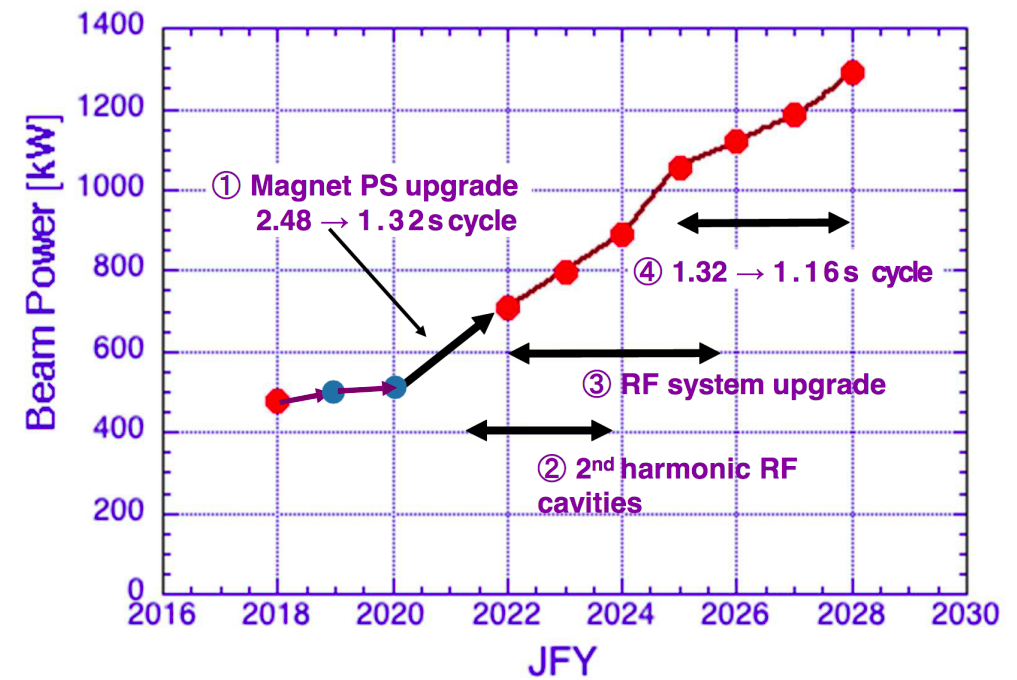
The current J-PARC Main Ring (MR) accelerates protons to 30GeV every 2.48s to provide a proton beam with power 515kW for the T2K experiment. The beamline upgrade aims to improve the beam power towards 750kW by 2022, and 1.3MW until the start of Hyper-K experiment, in order to increase the statistics for data taking. The increasing of beam power requires a larger number of spills and protons per spill to be reached, which can be achieved by increasing the beam repetition rate and reducing the beam loss and instabilities. The upgrade of power supplies and Radio Frequency cavity (RF) systems will help reduce the time between beam spills from 2.48s to 1.16s and improve the stability to increase the number of protons per spill from 2.65·1014 to 3.2·1014 by ~2026. The upgrade of beam profile monitors is also essential to adapt the increased beam power and number of proton interactions to measure the beam properties more precisely and reduce the systematic uncertainties in the neutrino flux measurements.
With the primary beamline (proton accelerators) upgrade, the improvement of the components from the neutrino extraction beamline is also required to accommodate the increased beam power. The proton beam impinges onto a 91.4cm long monolithic carbon target cooled by Helium gas. The cooling capacity is now increased and a new target is under development for the higher beam power, while new target types are also under consideration to further maximize the effective number of neutrinos produced. Upgrade of magnetic horns is important to improve the focusing of pions with particular signs that decay into neutrinos. The replacement of horn1 & horn2 and upgrading of power supplies and increasing its number from 2 to 3 are taking place, which will allow the current in the 3 horns to be increased from 250kA to 320kA, resulting in an increase in the right-sign neutrino (neutrinos for neutrino beam mode and antineutrinos for antineutrino beam mode) flux by 10% and a reduction of the wrong-sign neutrino flux by 5~10%. Inside the horns, the current-carrying striplines will be upgraded to use water cooling instead of He gas, while the piped water cooling capability around the He Vessel, decay volume and beam dump (other elements of the target station) will also be upgraded by increasing the water flow. The water tank is also being upgraded to have enough space for handling the disposed and diluted radioactive water produced during the neutrino beam production process. Electron-multiplier Tubes and MUMON Current Transformer are being developed for sensing the secondary muon (muons from pion decays) beam profile and muon sign measurement, respectively, at the muon monitor downstream the beam dump to increase the sensitivity of measuring the neutrino beam profile. On the other hand, improvements of beamline simulations can also be done by including additional constraints from extra hadron production experiments.
ND280 upgrade
The off-axis near detector ND280 is in use since the commissioning of the T2K experiment in 2009, and has played a major role in constraining systematic uncertainties, ultimately contributing to sufficient precision for the discovery of νμ → νe oscillations. With the J-PARC beam upgrade towards higher beam power, the next goal is to obtain sufficient statistics for the determination of CP-violation in the leptonic sector at a precision exceeding 3σ. This comes with the requirement to further reduce the remaining systematic errors. In particular, the current off-axis near detector is still constrained to angular acceptance of mostly forward going events, and in
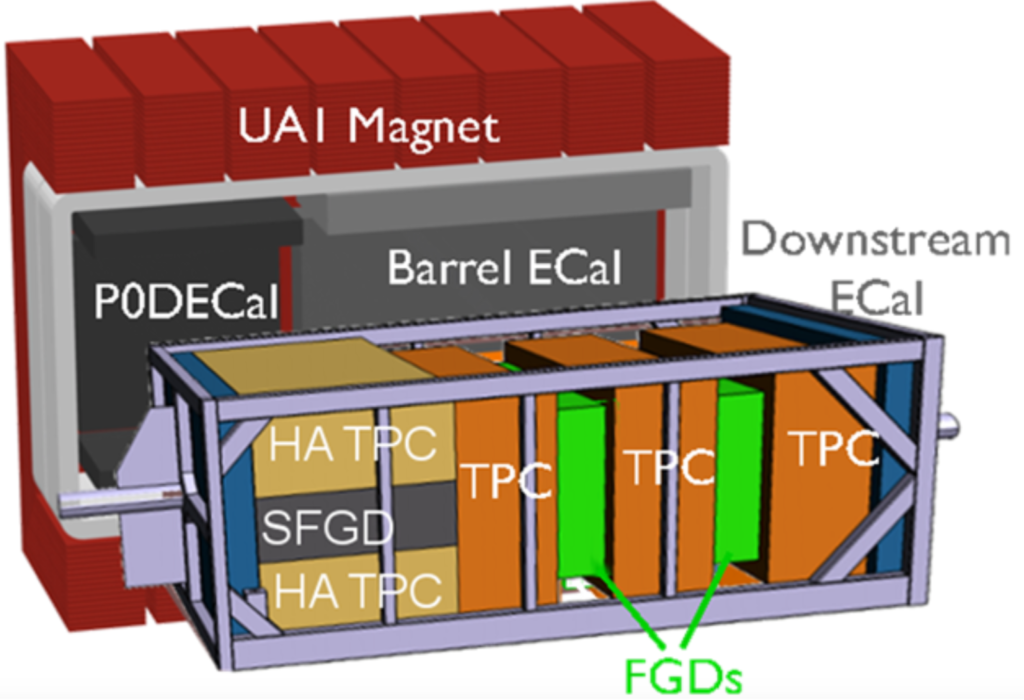
To improve these shortcomings, the π0 detector (P0D) of the current ND280 is replaced by three types of new sub-detectors: The Super-Fine-Grain Detector (SuperFGD), sandwiched between two High Angle Time Projection Chambers (HA-TPCs), and six Time of Flight planes (TOF) surrounding both SuperFGD and HA-TPCs. The SuperFGD is made of state-of-the-art plastic scintillator cubes, 1cm3 in size, with three perpendicular readout planes. The fine cuboid structure provides full angular acceptance due to its isotropic nature, which significantly increases the detection efficiency of short tracks thanks to the fact that signal from just one cube delivers 3D information and improves the position resolution compared to the current Fine Grain Detectors (FGD) based on scintillator bars. This allows a more precise measurement of protons and charged pions producing mostly short tracks, and enables the detection of neutrons via measurements of secondary particles produced in subsequent interactions. The HA-TPCs are equipped with cutting-edge readout technology, resistive MicroMegas, constituting a major improvement in the position resolution due to the spreading of the charge produced by particles ionising the gas in HA-TPCs. Their horizontal configuration allows the identification and momentum reconstruction for up and downward going tracks with respect to the neutrino beam, which is complementary to the forward-going particle information from the current, vertical TPCs. The exact timing information of particles surpassing the TOF allows to identify the particle direction and thus to distinguish particles produced inside the detector from the background produced outside of it. These assets of the new sub-detectors are the basis for more precise measurements of neutrino interaction cross-sections, including the ability to probe nuclear effects utilising measurements of low momentum hadrons.
Physics studies using data of T2K Phase II are expected to profit from a reduction in systematic uncertainties down to 4% (from currently 6%) due to the near detector upgrade. The ND280 upgrade is currently under preparation and will be completed in 2022/23.
SK-Gd
For most of its operational lifetime, Super-Kamiokande has been filled with ultrapure water. However
Better reconstruction of IBD events assists us in a number of different avenues of neutrino research. One of the most promising is in the search for so-called Supernova Relic Neutrinos (SRN) or Diffuse Supernova Neutrino Background (DSNB). Whilst galactic supernovae are rare phenomena, they are expected to occur roughly once per second in the entire universe. The neutrinos from all of these supernovae are expected to form a global flux that can be measured with SK-Gd. Measuring the relic signal can tell us about supernovae themselves; the rate of star formation in the universe, and the cosmology of the universe. The addition of Gd thus brings a new avenue of neutrino research into sight for Super Kamiokande.
Hyper-Kamiokande project
In the longer term, the plan is to start the successor of the T2K experiment – the Hyper-Kamiokande experiment. It will retain the existing neutrino beam, albeit upgraded to produce a more intense flux of neutrinos, and the upgraded near detector, but to replace Super-Kamiokande with a larger water Cherenkov detector, Hyper-Kamiokande. It is also planned to build the Intermediate Water Cherenkov Detector (IWCD) at a distance of 1-2 km from the neutrino source. Like Super-Kamiokande, Hyper-Kamiokande will have a mixed physics programme involving both neutrinos from J-PARC and atmospheric neutrinos from cosmic-ray interactions. Hyper-Kamiokande should begin operations around 2027.
For more information about Hyper-Kamiokande please visit the Hyper-Kamiokande web page.
Hyper-Kamiokande detector
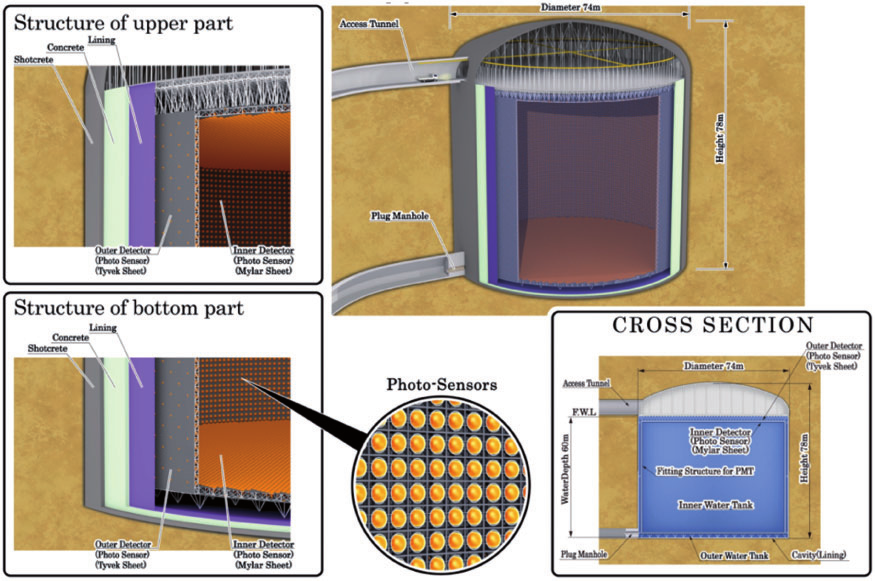
Hyper-Kamiokande is a third-generation Water Cherenkov detector – five times bigger than its predecessor Super-Kamiokande. The tank and cavern design for Hyper-Kamiokande construction are currently underway with the tunnel excavation in the process as of October 2021, and data taking planned for 2027. Just like Super-Kamiokande, it will have a cylindrical tank design, but with a height of 71m and a diameter of 68m, and due to its huge increase in volume it will be able to obtain an amount of data equivalent to 100 years of work of Super-K data collection time in the short span of only 10 years, leading to a much higher chance of detecting new physics.
Hyper-Kamiokande’s physics goals are many and varied, but the main ones include more precise CP violation measurement, better determination of neutrino mass ordering, cosmic neutrino detection and observing proton decay. Both the measurement of CP violation and the proton decay, are key to determining the reason behind the matter-antimatter asymmetry present in the universe, as they belong to Sakharov’s conditions necessary for baryogenesis. Hyper-Kamiokande will investigate CP violation by measuring differences between the flavour oscillation probabilities for neutrinos and for antineutrinos, and for 75% of the CP parameter space, it will be able to confirm non-zero CP violation with 3σ significance, and for over 50% of the parameter space with 5σ significance. Neutrino mass ordering is important to investigate because it will help to figure out which mechanism is responsible for neutrino mass generation. The ordering can be determined by a comparison of electron neutrino appearance in atmospheric neutrinos separately for neutrinos and for antineutrinos. The knowledge about mass ordering will also help to check whether the neutrino is its own antiparticle or not.
Hyper-Kamiokande will accomplish these measurements by using a detector which not only has a much larger fiducial volume compared to Super-Kamiokande but also vastly improved photosensors, which will exhibit a twice greater photodetection efficiency and an ability to measure light intensity and detection time with much greater precision. Multi-PMT Optical Modules, which involve using 19 3” PMTs housed in the same module as a normal 20” PMT module, will also be utilised giving an increased granularity for enhanced event reconstruction. This is especially important for multi-ring events and for events which take place near the detector wall. There would also be a reduced dark hit rate and better protection against PMT vessel implosion.
Intermediate Water Cherenkov Detector (IWCD)
The Intermediate Water Cherenkov Detector, or IWCD, is an intermediate near detector which has been proposed as part of the Hyper-Kamiokande long-baseline neutrino physics program. IWCD is a small scale water Cherenkov detector (6m height, 8m diameter) on the order of 300t, and will be placed approximately 1km from the beam production point at J-PARC.
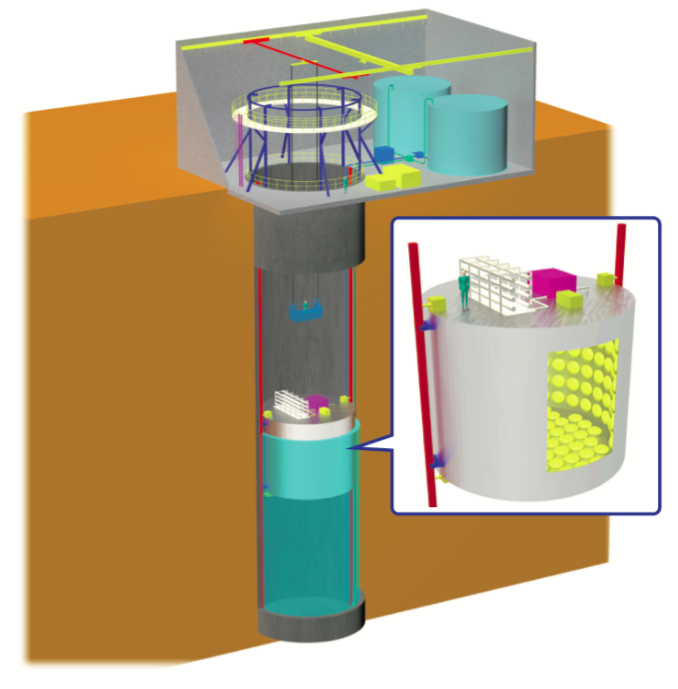
A schematic of the IWCD can be seen in the image to the left. The IWCD will be instrumented with “multi-PMT” or mPMT modules, the same as those discussed in the Water Cherenkov Test experiment (WCTE) section. The mPMTs will allow precise reconstruction of neutrino interactions through their fast time response and granularity.
The goal of the IWCD is to measure neutrino fluxes at multiple off-axis angle positions relative to the beam, to allow for studies of neutrino interaction models. Water Cherenkov detectors are well known for making very good electron neutrino measurements. Allowing a detector such as this to move in the vertical plane will make the IWCD a very powerful near detector.
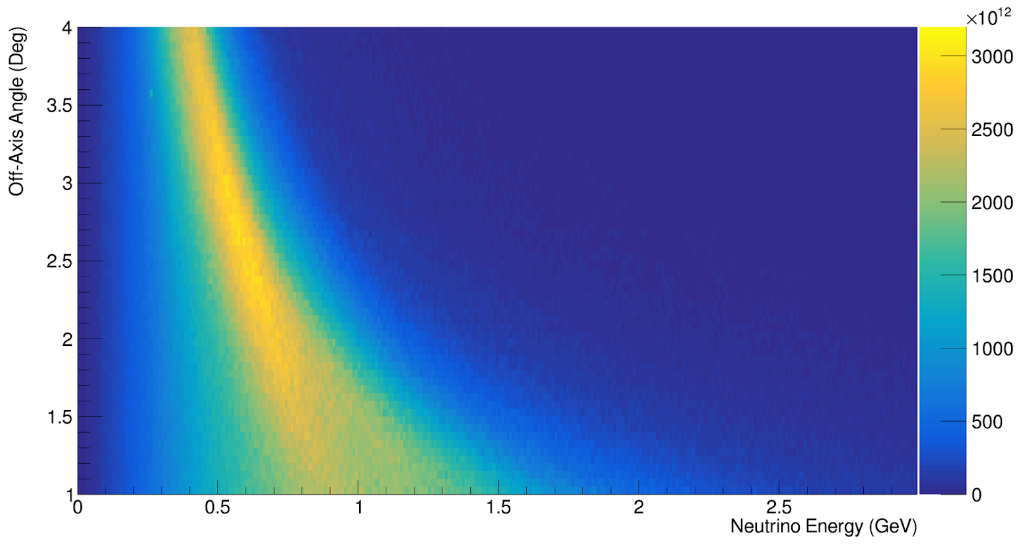
Why a moving detector? The energy spectrum between Hyper-Kamiokande and the near detectors differs due to neutrino oscillations, and the neutrino energy spectrum depends on the off-axis angle (see right-hand image).
Taking data at various points in a given off-axis range enables one to mimic the energy spectrums of interest including the spectrum at the Hyper-Kamiokande detector or a monochromatic beam. It is also possible to measure the differences in true and reconstructed energy over the energy spectrum and determine a “mis-reconstruction” factor for both CCQE and non-CCQE events.
Measurements of the electron neutrino cross-section will be essential, as the Hyper-Kamiokande CP violation sensitivity will be limited by the electron neutrino cross-section uncertainty, as the current uncertainty is theoretically driven and the available measurements are currently limited by statistical uncertainty. The measurements from IWCD will aid in addressing the systematic uncertainty limitation in the Hyper-Kamiokande long-baseline oscillation analysis.
Water Cherenkov Test Experiment (WCTE) at CERN
The Water Cherenkov Test Experiment (WCTE) is a small scale water Cherenkov detector
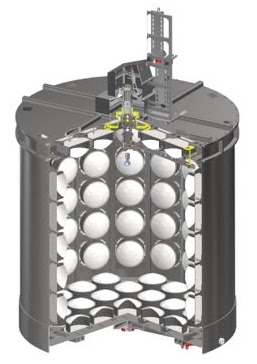
The WCTE detector design is similar to that of SK, where a stainless steel PMT support structure is housed inside a water tank. WCTE will, however, be on a much smaller scale at approximately 4m · 4m, and will be instrumented with the multi-PMT module (mPMT) rather than the large 20” PMTs which are used in SK. Nineteen 8cm diameter PMTs (Hamamatsu R14374) make up a single mPMT, which allows for an improved granularity and timing compared to using larger single PMTs. A cross-section of the detector is shown in the figure to the left, where the stainless steel tank, support structure and mPMT modules are visible. Also visible is a 3 axis calibration system that will be used to deploy multiple calibration devices at specified positions inside the detector.
The physics studies of WCTE include
- Cherenkov light production/processes can be difficult to study in large detectors.
- Energy scale calibration
- For HK, the energy scale uncertainty should be on the scale of 0.5%, whereas the current error at SK is 2%.
- Study of energy scale and calibration techniques will work to reduce energy scale uncertainties in larger detectors.
- Secondary neutron production which is used for neutrino/anti-neutrino tagging in SK-Gd and HK
- Pion scattering
- Reconstruction of pions in the final state can be challenging due to limited modelling of hadronic scattering on oxygen.
There will be two beam configurations that both utilize the same particle beam. In the first configuration beam momenta are ranging from 300MeV/c to 1500MeV/c. The second configuration allows for the study of low momentum pions and protons.








